Our Favorite Valentines Throughout The Universe
Our Favorite Valentines Throughout the Universe
Today is Valentine’s Day. What better way to express that you love someone than with an intergalactic love gram? Check out some of our favorites and send them to all of your cosmic companions:
Your love is galactic

The Hubble Space Telescope revolutionized nearly all areas of astronomical research — and captured some truly lovely images. Here, a pair of intersecting galaxies swirl into the shape of a rose as a result of gravitational tidal pull. What type of roses are you getting for your love — red or galactic?
I think you’re n{ice}

IceBridge is the largest airborne survey of Earth’s polar ice ever flown. It captures 3-D views of Arctic and Antarctic ice sheets, ice shelves and sea ice. This lovely heart-shaped glacier feature was discovered in northwest Greenland during an IceBridge flight in 2017. Which of your lover’s features would you say are the coolest?
You’re absolutely magnetic

Even though we can’t see them, magnetic fields are all around us. One of the solar system’s largest magnetospheres belongs to Jupiter. Right now, our Juno spacecraft is providing scientists with their first glimpses of this unseen force. Is your attraction to your loved one magnetic?
You’re MARS-velous

This heart-shaped feature on the Martian landscape was captured by our Mars Reconnaissance Orbiter. It was created by a small impact crater that blew darker material on the surface away. What impact has your loved one had on you?
I <3 you

From three billion miles away, Pluto sent a “love note” back to Earth, via our New Horizons spacecraft. This stunning image of Pluto’s “heart” shows one of the world’s most dominant features, estimated to be 1,000 miles (1,600 km) across at its widest point. Will you pass this love note on to someone special in your life?
Light of my life

Our Solar Dynamics Observatory keeps an eye on our closest star that brings energy to you and your love. The observatory helps us understand where the Sun’s energy comes from, how the inside of the Sun works, how energy is stored and released in the Sun’s atmosphere and much more. Who would you say is your ray of sunshine?
Do any of these cosmic phenomena remind you of someone in your universe? Download these cards here to send to all the stars in your sky.
Want something from the Red Planet to match your bouquet of red roses? Here is our collection of Martian Valentines.
Make sure to follow us on Tumblr for your regular dose of space: http://nasa.tumblr.com
More Posts from Ocrim1967 and Others
Scientists push back against Harvard 'alien spacecraft' theory

This photo released by the European Southern Observatory on November 20, 2017 shows an artist’s impression of the first interstellar object known to enter our solar system: ‘Oumuamua
A scientific paper led by two researchers at Harvard University made a splash this week by claiming that a cigar-shaped rock zooming through our solar system may have been sent by aliens.
The researchers noted in a pre-print of the article that it was an “exotic scenario,” but that “Oumuamua may be a fully operational probe sent intentionally to Earth vicinity by an alien civilization.”
Oumuamua, the first interstellar object known to enter our solar system, accelerated faster away from the Sun than expected, hence the notion that some kind of artificial sail that runs on sunlight—known as a light sail—may have helped push it through space.
“Currently there is an unexplained phenomena, namely, the excess acceleration of Oumuamua, which we show may be explained by the force of radiation pressure from the sun,” co-author and Harvard astrophysicist Shmuel Bialy told AFP via email Tuesday.
“However this requires the body to have a very large surface and be very thin, which is not encountered in nature.”
Their suggestion of an alien force at work went viral.
But other astronomy experts aren’t buying it.
“Like most scientists, I would love there to be convincing evidence of alien life, but this isn’t it,” said Alan Fitzsimmons, an astrophysicist at Queens University, Belfast.
“It has already been shown that its observed characteristics are consistent with a comet-like body ejected from another star system,” he told AFP.
“And some of the arguments in this study are based on numbers with large uncertainties.”
Read more ~ phys.org

A photo released by the European Space Agency on June 27, 2018 shows an artist’s impression of ‘Oumuamua Editor’s note: Any cometary outgassing required to provide acceleration would have been detectable. None detected. What kills the alien probe theory for me is it’s velocity. Fast enough to buzz through the solar system without being snared by the sun but WAY too slow for practical interstellar travel although it’s trajectory put it on a nice path for exploration.

Credit : NASA - https://www.nasa.gov/feature/jpl/small-asteroid-or-comet-visits-from-beyond-the-solar-system, Public Domain, https://commons.wikimedia.org/w/index.php?curid=64030370
WE NEED TO ACT NOW







The role plastic products play in the daily lives of people all over the world is interminable. We could throw statistics at you all day long (e.g. Upwards of 300 MILLION tons of plastic are consumed each year), but the impact of these numbers border on inconceivable.
For those living on the coasts, a mere walk on the beach can give anyone insight into how staggering our addiction to plastic has become as bottles, cans, bags, lids and straws (just to name a few) are ever-present. In other areas that insight is more poignant as the remains of animal carcasses can frequently be observed; the plastic debris that many of them ingested or became entangled in still visible long after their death. Sadly, an overwhelming amount of plastic pollution isn’t even visible to the human eye, with much of the pollution occurring out at sea or on a microscopic level.
The short-lived use of millions of tons of plastic is, quite simply, unsustainable and dangerous. We have only begun to see the far-reaching consequences of plastic pollution and how it affects all living things. According to a study from Plymouth University, plastic pollution affects at least 700 marine species, while some estimates suggest that at least 100 million marine mammals are killed each year from plastic pollution. Here are some of the marine species most deeply impacted by plastic pollution.
Sea Turtles
Seals and Sea Lions
Seabirds
Fish
Whales and Dolphins

–> GET HERE THE OCEAN SEA PIN <–

–> GET HERE THE A LITTLE MORE KINDNESS A LITTLE LESS JUDGEMENT PIN <–

–> GET HERE 4 PACK GALAXY FISHES PINS <–

–> GET HERE THE IT’S A SMALL WORLD AFTER ALL PIN <–

–> GET HERE THE SEA LOVERS PIN <–

–> GET HERE THE IF YOU’RE LOOKING FOR A SIGN THIS IS IT PIN <–

More than ever, the fate of the ocean is in our hands. To be good stewards and leave a thriving ocean for future generations, we need to make changes big and small wherever we are.
Every purchase supports Ocean Conservation. We give a portion of our profits to Organizations that bravely fight for Marine Conservation.

Far from Westeros, a Three-Eyed Raven Helps NASA Find Its Way
Perched on the outside of the International Space Station is Raven—a technology-filled module that helps NASA develop a relative navigation capability, which is essentially autopilot for spacecraft. Raven has been testing technologies to enable autonomous rendezvous in space, which means the ability to approach things in space without human involvement, even from the ground.

Developed by the Satellite Servicing Projects Division (SSPD), our three-eyed Raven has visible, infrared, and Lidar sensors and uses those “eyes” to image and track visiting spacecraft as they come and go from the space station. Although Raven is all-seeing, it only sees all in black and white. Color images do not offer an advantage in the case of Raven and Restore-L, which also utilize infrared and Lidar sensors.
The data from Raven’s sensors is sent to its processor, which autonomously sends commands that swivel Raven on its gimbal, or pointing system. When Raven turns using this system, it is able to track a vehicle. While these maneuvers take place, NASA operators evaluate the movements and make adjustments to perfect the relative navigation system technologies.

A few days ago, Raven completed its 21st observation of a spacecraft when it captured images of Northrop Grumman’s Cygnus vehicle delivering science investigations and supplies as part of its 11th commercial resupply services mission, including another SSPD payload called the Robotic External Leak Locator.

And just last month, Raven celebrated its two-year anniversary in space, marking the occasion with an observation of SpaceX’s Crew Dragon during the Demo-1 mission.

What is this—a spacecraft for ants??
While this shot of Dragon isn’t terribly impressive because of where the spacecraft docked on station, Raven has captured some truly great images when given the right viewing conditions.
From SpaceX Dragon resupply mission observations…

…to Cygnus supply vehicles.

Raven has observed six unique types of spacecraft.
It has also conducted a few observations not involving spacecraft, including the time it captured Hurricane Irma…

…or the time it captured station’s Dextre arm removing the Robotic Refueling Mission 3 payload, another mission developed by SSPD, from the Dragon spacecraft that delivered it to the orbiting laboratory.


Thus far, Raven has had a great, productive life aboard the station, but its work isn’t done yet! Whether it’s for Restore-L, which will robotically refuel a satellite, or getting humans to the Moon or Mars, the technologies Raven is demonstrating for a relative navigation system will support future NASA missions for decades to come.

Make sure to follow us on Tumblr for your regular dose of space: http://nasa.tumblr.com
What is a Wormhole?
Wormholes were first theorized in 1916, though that wasn’t what they were called at the time. While reviewing another physicist’s solution to the equations in Albert Einstein’s theory of general relativity, Austrian physicist Ludwig Flamm realized another solution was possible. He described a “white hole,” a theoretical time reversal of a black hole. Entrances to both black and white holes could be connected by a space-time conduit.

In 1935, Einstein and physicist Nathan Rosen used the theory of general relativity to elaborate on the idea, proposing the existence of “bridges” through space-time. These bridges connect two different points in space-time, theoretically creating a shortcut that could reduce travel time and distance. The shortcuts came to be called Einstein-Rosen bridges, or wormholes.

Certain solutions of general relativity allow for the existence of wormholes where the mouth of each is a black hole. However, a naturally occurring black hole, formed by the collapse of a dying star, does not by itself create a wormhole.
Wormholes are consistent with the general theory of relativity, but whether wormholes actually exist remains to be seen.

A wormhole could connect extremely long distances such as a billion light years or more, short distances such as a few meters, different universes, or different points in time
For a simplified notion of a wormhole, space can be visualized as a two-dimensional (2D) surface. In this case, a wormhole would appear as a hole in that surface, lead into a 3D tube (the inside surface of a cylinder), then re-emerge at another location on the 2D surface with a hole similar to the entrance. An actual wormhole would be analogous to this, but with the spatial dimensions raised by one. For example, instead of circular holes on a 2D plane, the entry and exit points could be visualized as spheres in 3D space.

Science fiction is filled with tales of traveling through wormholes. But the reality of such travel is more complicated, and not just because we’ve yet to spot one.

The first problem is size. Primordial wormholes are predicted to exist on microscopic levels, about 10–33 centimeters. However, as the universe expands, it is possible that some may have been stretched to larger sizes.
Another problem comes from stability. The predicted Einstein-Rosen wormholes would be useless for travel because they collapse quickly.

“You would need some very exotic type of matter in order to stabilize a wormhole,” said Hsu, “and it’s not clear whether such matter exists in the universe.”
But more recent research found that a wormhole containing “exotic” matter could stay open and unchanging for longer periods of time.

Exotic matter, which should not be confused with dark matter or antimatter, contains negative energy density and a large negative pressure. Such matter has only been seen in the behavior of certain vacuum states as part of quantum field theory.
If a wormhole contained sufficient exotic matter, whether naturally occurring or artificially added, it could theoretically be used as a method of sending information or travelers through space. Unfortunately, human journeys through the space tunnels may be challenging.

Wormholes may not only connect two separate regions within the universe, they could also connect two different universes. Similarly, some scientists have conjectured that if one mouth of a wormhole is moved in a specific manner, it could allow for time travel.

Although adding exotic matter to a wormhole might stabilize it to the point that human passengers could travel safely through it, there is still the possibility that the addition of “regular” matter would be sufficient to destabilize the portal.
Today’s technology is insufficient to enlarge or stabilize wormholes, even if they could be found. However, scientists continue to explore the concept as a method of space travel with the hope that technology will eventually be able to utilize them.
source
source
images: x, x, x, x, x, x, x, x, x





Study Tips Based on Your Hogwarts House
Just finished rewatching all 8 of the Harry Potter films last week… and I thought why not make my first graphic related to it? So, here’s study tips for each of the Hogwarts houses! I know some of these doesn’t apply to everyone, but I had really fun time making this :) Hope this helps!
50 Reasons It's Time For Smartphones In Every Classroom

“There are many ways to use a smartphone in the classroom, but it continues to be a touchy subject. Privacy, equity, bandwidth, lesson design, classroom management, theft, bullying, and scores of other legitimate concerns continue to cloud education’s thinking about how to meaningfully integrate technology in the learning process.”










This One Thought Experiment Shows Why Special Relativity Isn’t The Full Story
“In Einstein’s initial formulation of General Relativity way back in 1916, he mentioned the gravitational redshift (and blueshift) of light as a necessary consequence of his new theory, and the third classical test, after the precession of Mercury’s perihelion (already known at the time) and the deflection of starlight by a gravitational source (discovered during a total solar eclipse in 1919).
Although a thought experiment is an extremely powerful tool, practical experiments didn’t catch up until 1959, where the Pound-Rebka experiment finally measured a gravitational redshift/blueshift directly. Yet just by invoking the idea that energy must be conserved, and a basic understanding of particle physics and gravitational fields, we can learn that light must change its frequency in a gravitational field.”
If a photon flies through space towards Earth, it must gain energy and become bluer in nature as it approaches Earth’s surface. This idea, of a gravitational redshift or blueshift, dictates how a photon must change in energy in the presence of a gravitational field. Yet this effect, which only exists in General Relativity, could have been predicted as soon as special relativity was discovered by one simple thought experiment: to consider a particle-antiparticle pair dropped from high above the surface of the Earth, but to let the annihilation occur at varying locations.
If you considered that, you’d immediately realize how special relativity was insufficient for describing our Universe! Come learn how to reason it out for yourself today!

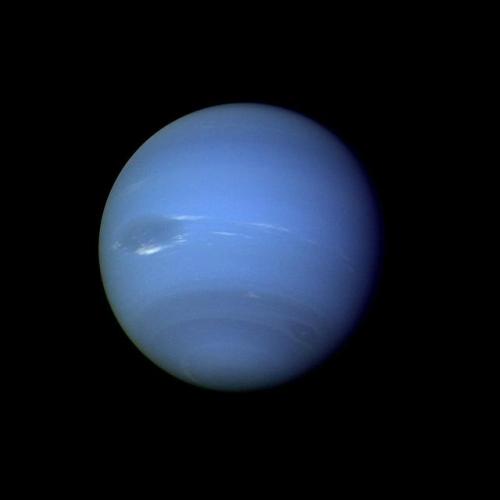
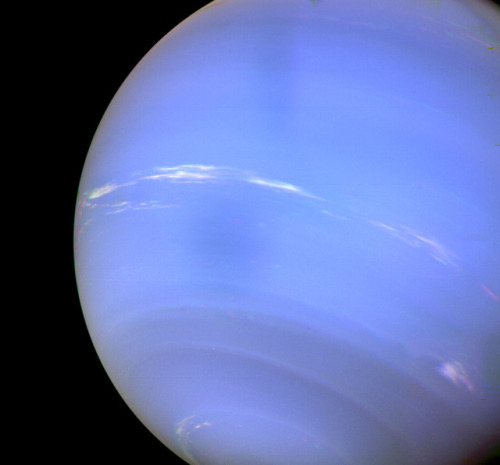
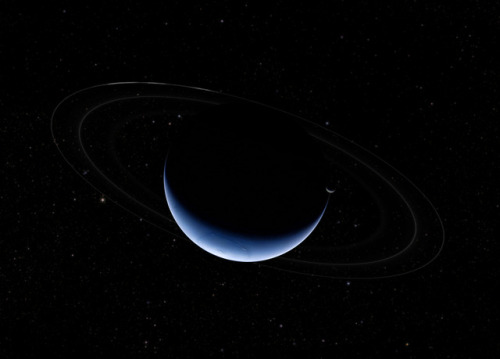
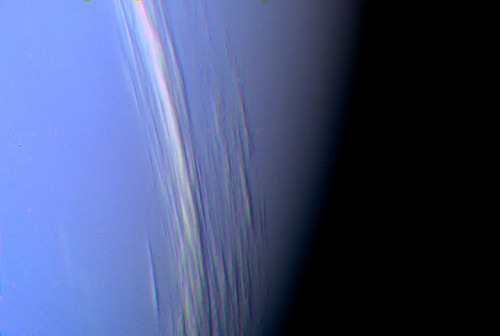
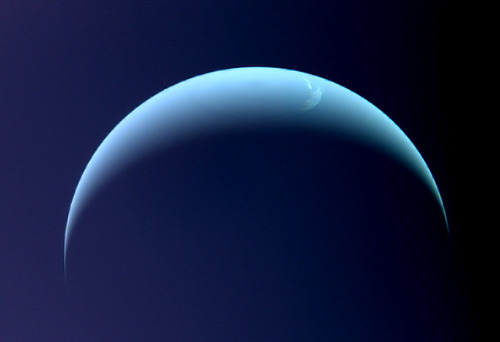
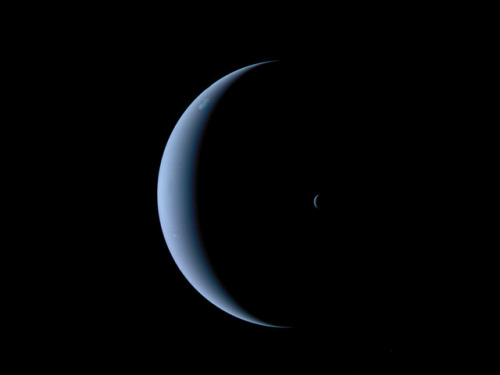
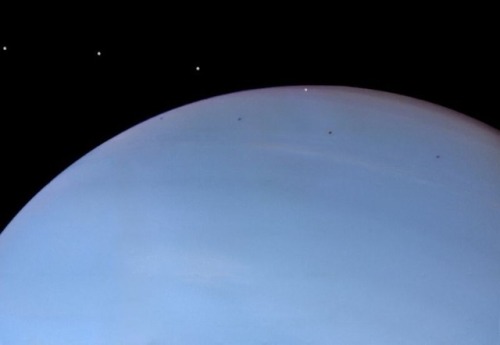
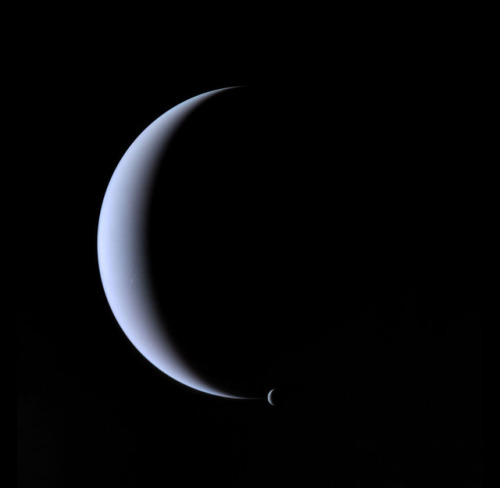
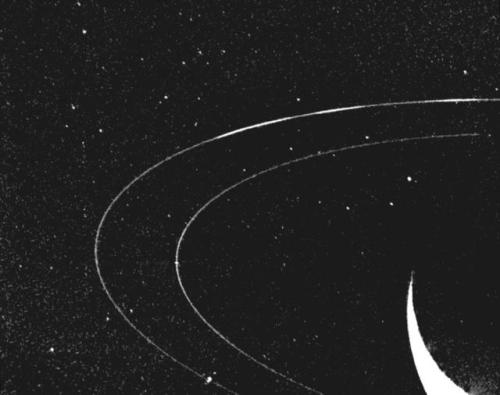
Neptune ♆
On this day in 1846 was discovered the planet Neptune.
The ice giant Neptune was the first planet located through mathematical predictions rather than through regular observations of the sky. (Galileo had recorded it as a fixed star during observations with his small telescope in 1612 and 1613.) When Uranus didn’t travel exactly as astronomers expected it to, a French mathematician, Urbain Joseph Le Verrier, proposed the position and mass of another as yet unknown planet that could cause the observed changes to Uranus’ orbit. After being ignored by French astronomers, Le Verrier sent his predictions to Johann Gottfried Galle at the Berlin Observatory, who found Neptune on his first night of searching in 1846. Seventeen days later, its largest moon, Triton, was also discovered.
Neptune is invisible to the naked eye because of its extreme distance from Earth. Interestingly, the highly eccentric orbit of the dwarf planet Pluto brings Pluto inside Neptune’s orbit for a 20-year period out of every 248 Earth years. Pluto can never crash into Neptune, though, because for every three laps Neptune takes around the Sun, Pluto makes two. This repeating pattern prevents close approaches of the two bodies.
Nearly 4.5 billion kilometers (2.8 billion miles) from the Sun, Neptune orbits the Sun once every 165 years.
Uranus’ blue-green color is also the result of atmospheric methane, but Neptune is a more vivid, brighter blue, so there must be an unknown component that causes the more intense color.
Despite its great distance and low energy input from the Sun, Neptune’s winds can be three times stronger than Jupiter’s and nine times stronger than Earth’s.
Winds on Neptune travel faster than the speed of sound.
In 1989, Voyager 2 tracked a large, oval-shaped, dark storm in Neptune’s southern hemisphere. This “Great Dark Spot” was large enough to contain the entire Earth.
Neptune has five known rings. Voyager 2’s observations confirmed that these unusual rings are not uniform but have four thick regions (clumps of dust) called arcs. The rings are thought to be relatively young and short-lived.
Neptune has 14 known moons, six of which were discovered by Voyager 2.
Triton, Neptune’s largest moon, orbits the planet in the opposite direction compared with the rest of the moons, suggesting that it may have been captured by Neptune in the distant past.
To know more about the planet Neptune click here and here.
Images credit: NASA/JPL- Caltech (some images processed by Kevin M. Gill)
Make Sure You Observe the Moon on October 20
On Saturday, October 20, NASA will host the ninth annual International Observe the Moon Night. One day each year, everyone on Earth is invited to observe and learn about the Moon together, and to celebrate the cultural and personal connections we all have with our nearest celestial neighbor.
There are a number of ways to celebrate. You can attend an event, host your own, or just look up! Here are 10 of our favorite ways to observe the Moon:
1. Look up

Image credit: NASA’s Scientific Visualization Studio/Ernie Wright
The simplest way to observe the Moon is simply to look up. The Moon is the brightest object in our night sky, the second brightest in our daytime sky and can be seen from all around the world — from the remote and dark Atacama Desert in Chile to the brightly lit streets of Tokyo. On October 20, the near side of the Moon, or the side facing Earth, will be about 80 percent illuminated, rising in the early evening.
See the Moon phase on October 20 or any other day of the year!
2. Peer through a telescope or binoculars

The Moon and Venus are great targets for binoculars. Image Credit: NASA/Bill Dunford
With some magnification help, you will be able to focus in on specific features on the Moon, like the Sea of Tranquility or the bright Copernicus Crater. Download our Moon maps for some guided observing on Saturday.
3. Photograph the Moon

Image credit: NASA/GSFC/ASU
Our Lunar Reconnaissance Orbiter (LRO) has taken more than 20 million images of the Moon, mapping it in stunning detail. You can see featured, captioned images on LRO’s camera website, like the one of Montes Carpatus seen here. And, of course, you can take your own photos from Earth. Check out our tips on photographing the Moon!
4. Take a virtual field trip

Image credit: NASA/JPL-Caltech
Plan a lunar hike with Moontrek. Moontrek is an interactive Moon map made using NASA data from our lunar spacecraft. Fly anywhere you’d like on the Moon, calculate the distance or the elevation of a mountain to plan your lunar hike, or layer attributes of the lunar surface and temperature. If you have a virtual reality headset, you can experience Moontrek in 3D.
5. Touch the topography

Image credit: NASA GSFC/Jacob Richardson
Observe the Moon through touch! If you have access to a 3D printer, you can peruse our library of 3D models and lunar landscapes. This model of the Apollo 11 landing site created by NASA scientist Jacob Richardson, is derived from LRO’s topographic data. Near the center, you can actually feel a tiny dot where astronauts Neil Armstrong and Buzz Aldrin left the Lunar Descent Module.
6. Make Moon art

Image credit: LPI/Andy Shaner
Enjoy artwork of the Moon and create your own! For messy fun, lunar crater paintings demonstrate how the lunar surface changes due to consistent meteorite impacts.
7. Relax on your couch

Image credit: NASA’s Scientific Visualization Studio/Ernie Wright
There are many movies that feature our nearest neighbor, from A Voyage to the Moon by George Melies, to Apollo 13, to the newly released First Man. You can also spend your evening with our lunar playlist on YouTube or this video gallery, learning about the Moon’s role in eclipses, looking at the Moon phases from the far side, and seeing the latest science portrayed in super high resolution. You’ll impress all of your friends with your knowledge of supermoons.
8. Listen to the Moon
Video credit: NASA’s Scientific Visualization Studio/Ernie Wright
Make a playlist of Moon songs. For inspiration, check out this list of lunar tunes. We also recommend LRO’s official music video, The Moon and More, featuring Javier Colon, season 1 winner of NBC’s “The Voice.” Or you can just watch this video featuring “Clair de Lune,” by French composer Claude Debussy, over and over.
9. See the Moon through the eyes of a spacecraft

Image credit: NASA/GSFC/MIT
Visible light is just one tool that we use to explore our universe. Our spacecraft contain many different types of instruments to analyze the Moon’s composition and environment. Review the Moon’s gravity field with data from the GRAIL spacecraft or decipher the maze of this slope map from the laser altimeter onboard LRO. This collection from LRO features images of the Moon’s temperature and topography. You can learn more about our different missions to explore the Moon here.
10. Continue your observations throughout the year

Image credit: NASA’s Scientific Visualization Studio/Ernie Wright
An important part of observing the Moon is to see how it changes over time. International Observe the Moon Night is the perfect time to start a Moon journal. See how the shape of the Moon changes over the course of a month, and keep track of where and what time it rises and sets. Observe the Moon all year long with these tools and techniques!
However you choose to celebrate International Observe the Moon Night, we want to hear about it! Register your participation and share your experiences on social media with #ObserveTheMoon or on our Facebook page. Happy observing!
Make sure to follow us on Tumblr for your regular dose of space: http://nasa.tumblr.com.








If the Moon were replaced with some of our planets (at night)
Image credit: yeti dynamics
-
 transparentcowboydonutwease-blog liked this · 11 months ago
transparentcowboydonutwease-blog liked this · 11 months ago -
 ask-carmen-sandiego liked this · 1 year ago
ask-carmen-sandiego liked this · 1 year ago -
 postcardsfromliminalplaces liked this · 3 years ago
postcardsfromliminalplaces liked this · 3 years ago -
 snowrainandbooks liked this · 3 years ago
snowrainandbooks liked this · 3 years ago -
 creativeperso-n liked this · 3 years ago
creativeperso-n liked this · 3 years ago -
 jupiter-ortega liked this · 4 years ago
jupiter-ortega liked this · 4 years ago -
 squidskingdom liked this · 4 years ago
squidskingdom liked this · 4 years ago -
 harukaminami liked this · 4 years ago
harukaminami liked this · 4 years ago -
 coconuts-coco reblogged this · 4 years ago
coconuts-coco reblogged this · 4 years ago -
 coconuts-coco liked this · 4 years ago
coconuts-coco liked this · 4 years ago -
 shipwiththesnake liked this · 4 years ago
shipwiththesnake liked this · 4 years ago -
 alfhildr-the-word-weaver liked this · 4 years ago
alfhildr-the-word-weaver liked this · 4 years ago -
 princejupiter17 liked this · 4 years ago
princejupiter17 liked this · 4 years ago -
 1lilbirdie liked this · 4 years ago
1lilbirdie liked this · 4 years ago -
 smokeringsofsaturn liked this · 4 years ago
smokeringsofsaturn liked this · 4 years ago -
 dreadfullynervousihadbeen liked this · 4 years ago
dreadfullynervousihadbeen liked this · 4 years ago -
 sta-r-gazing reblogged this · 4 years ago
sta-r-gazing reblogged this · 4 years ago -
 sta-r-gazing liked this · 4 years ago
sta-r-gazing liked this · 4 years ago -
 adrummersspambeat reblogged this · 4 years ago
adrummersspambeat reblogged this · 4 years ago -
 drummersheartbeat liked this · 4 years ago
drummersheartbeat liked this · 4 years ago -
 1a6ue liked this · 4 years ago
1a6ue liked this · 4 years ago -
 wildywindymoors liked this · 4 years ago
wildywindymoors liked this · 4 years ago -
 thekidwithoutaname liked this · 4 years ago
thekidwithoutaname liked this · 4 years ago -
 dennamicamsm liked this · 4 years ago
dennamicamsm liked this · 4 years ago -
 bubba-san liked this · 4 years ago
bubba-san liked this · 4 years ago -
 stress-cactus reblogged this · 4 years ago
stress-cactus reblogged this · 4 years ago -
 stress-cactus liked this · 4 years ago
stress-cactus liked this · 4 years ago -
 mrigllama liked this · 4 years ago
mrigllama liked this · 4 years ago -
 silv3r-and-gold3n-t3ars liked this · 4 years ago
silv3r-and-gold3n-t3ars liked this · 4 years ago -
 phellz liked this · 4 years ago
phellz liked this · 4 years ago -
 landsurfingpro liked this · 4 years ago
landsurfingpro liked this · 4 years ago -
 angmatange liked this · 4 years ago
angmatange liked this · 4 years ago -
 embrinafeels22267 liked this · 4 years ago
embrinafeels22267 liked this · 4 years ago -
 oc45 liked this · 4 years ago
oc45 liked this · 4 years ago -
 sampaiobrunno reblogged this · 5 years ago
sampaiobrunno reblogged this · 5 years ago -
 sampaiobrunno liked this · 5 years ago
sampaiobrunno liked this · 5 years ago -
 intertwined-xx liked this · 5 years ago
intertwined-xx liked this · 5 years ago -
 theworldismyoysterandiamthepearl liked this · 5 years ago
theworldismyoysterandiamthepearl liked this · 5 years ago -
 selectordk-blog liked this · 5 years ago
selectordk-blog liked this · 5 years ago -
 softwitchsstuff liked this · 5 years ago
softwitchsstuff liked this · 5 years ago -
 botticegli liked this · 5 years ago
botticegli liked this · 5 years ago -
 treasuretroveblog liked this · 5 years ago
treasuretroveblog liked this · 5 years ago